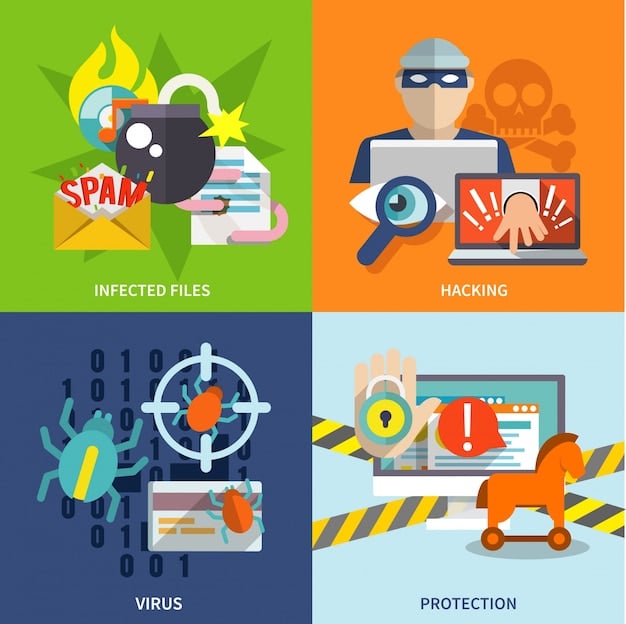Insider Threats: Detection and Prevention Strategies for Data Security

Insider threats pose a significant risk to data security, stemming from employees or individuals with privileged access; detecting and preventing these threats requires a multifaceted approach encompassing technology, policies, and employee training.
In today’s digital landscape, organizations face a constant barrage of cybersecurity threats. While external attacks often grab headlines, a less visible yet equally dangerous risk comes from within: insider threats. Understanding, detecting, and preventing data breaches originating from employees or trusted insiders is crucial for safeguarding sensitive information and maintaining business continuity.
Understanding Insider Threats
Insider threats are security risks that originate from within an organization. These threats can be malicious or unintentional, but both can cause significant damage. Understanding the different types of insider threats and their motivations is crucial for effective prevention.
Types of Insider Threats
Insider threats are not monolithic; they encompass a range of individuals and motivations. Some are intentional, while others are accidental. Recognizing these distinctions is vital for tailoring security measures.
- Malicious Insiders: These individuals intentionally steal or damage data for personal gain, revenge, or ideological reasons.
- Negligent Insiders: These employees unintentionally expose data through carelessness, lack of awareness, or failure to follow security protocols.
- Compromised Insiders: These are individuals whose accounts have been compromised by external attackers, who then use the insider’s access to steal data.
Malicious insiders often seek financial gain by selling stolen data on the dark web or to competitors. Negligent insiders may simply be unaware of the risks associated with their actions, such as clicking on phishing links or sharing sensitive information insecurely. Compromised insiders are victims of external attacks, highlighting the importance of strong account security measures.

Motivations Behind Insider Threats
Understanding why insiders might pose a threat is crucial for prevention. Motivations can range from financial gain to dissatisfaction with the company. Identifying potential indicators of these motivations can help mitigate the risk.
- Financial Gain: Insiders may seek to profit by stealing and selling sensitive data, such as customer information or trade secrets.
- Revenge: Disgruntled employees may intentionally damage or steal data as an act of retaliation against the company.
- Ideology: Some insiders may be motivated by ideological beliefs, such as activism or espionage, to leak or sabotage data.
Financial pressures, such as debt or gambling problems, can drive insiders to steal data for profit. Perceived unfair treatment or lack of recognition can fuel feelings of resentment and lead to revenge-motivated actions. Understanding these potential triggers allows organizations to proactively address employee concerns and reduce the risk of insider threats.
In conclusion, understanding the types and motivations behind insider threats is the first step in building an effective defense strategy. By recognizing the different faces of insider threats, organizations can tailor their security measures to address specific risks and vulnerabilities.
Detecting Insider Threats: Key Indicators
Detecting insider threats early is crucial to minimize damage. Monitoring user behavior, identifying anomalies, and leveraging data loss prevention tools are essential strategies. A proactive approach can help identify potential threats before they escalate into full-blown breaches.
Monitoring User Behavior
Monitoring user activity is a cornerstone of insider threat detection. Tracking employee access patterns, data usage, and communication can reveal suspicious behavior that warrants further investigation.
Implementing user and entity behavior analytics (UEBA) tools can automate the process of monitoring user behavior. These tools use machine learning algorithms to establish baseline activity patterns and identify deviations that may indicate malicious intent or compromised accounts. For example, UEBA can flag instances of employees accessing sensitive data outside of normal working hours or from unusual locations.
Identifying Anomalies
Anomalous behavior can be a red flag indicating a potential insider threat. Sudden changes in data access patterns, unusual file transfers, or attempts to bypass security controls should be investigated promptly.
Organizations should establish clear protocols for investigating anomalies. This includes defining escalation procedures and assigning responsibility for incident response. For example, if an employee starts downloading large amounts of data to a personal device, this should trigger an alert and prompt an immediate investigation.
- Sudden increases in data downloads or uploads
- Accessing sensitive data outside of normal working hours
- Attempts to bypass security controls
Each of these potential red flags requires a comprehensive investigation to determine the root cause.
In conclusion, detecting insider threats requires a proactive and vigilant approach. By implementing robust monitoring systems, identifying anomalies, and leveraging data loss prevention tools, organizations can significantly reduce their risk of insider-related data breaches.
Implementing Data Loss Prevention (DLP) Strategies
Data Loss Prevention (DLP) strategies are critical for protecting sensitive information from insider threats. DLP solutions monitor data in use, in transit, and at rest to prevent unauthorized access and exfiltration.
What is DLP?
DLP is a set of technologies and practices designed to prevent sensitive data from leaving an organization’s control. DLP solutions can identify, monitor, and protect data by analyzing its content and context.
DLP solutions can be deployed on endpoints, networks, and in the cloud. They use a variety of techniques, such as pattern matching, keyword analysis, and data fingerprinting, to identify sensitive data. When sensitive data is detected, DLP solutions can take actions such as blocking the transfer, encrypting the data, or generating an alert.
Key Components of a DLP Strategy
An effective DLP strategy involves several key components, including data classification, policy enforcement, and incident response. Each component plays a crucial role in protecting sensitive data from insider threats.
- Data Classification: Identifying and classifying sensitive data based on its value and risk level.
- Policy Enforcement: Defining and enforcing policies that govern how sensitive data is accessed, used, and shared.
- Incident Response: Establishing procedures for responding to DLP incidents, such as data breaches or policy violations.

Data classification is the foundation of a DLP strategy. By categorizing data based on its sensitivity, organizations can prioritize their security efforts and implement appropriate controls. Policy enforcement ensures that employees adhere to data security policies and procedures. Incident response provides a framework for quickly and effectively addressing data breaches or policy violations.
In conclusion, implementing DLP strategies is essential for protecting sensitive data from insider threats. By understanding the key components of a DLP strategy and deploying appropriate solutions, organizations can significantly reduce their risk of data loss and maintain regulatory compliance.
Building a Strong Security Culture
A strong security culture is essential for preventing insider threats. Educating employees, promoting awareness, and fostering a sense of responsibility can significantly reduce the risk of unintentional data breaches.
The Importance of Employee Education
Educating employees about security risks and best practices is crucial for creating a security-conscious workforce. Training programs should cover topics such as phishing awareness, password security, and data handling procedures.
Regular security awareness training can help employees recognize and avoid common threats, such as phishing scams and social engineering attacks. Training should be tailored to the specific roles and responsibilities of employees, with a focus on practical skills that can be applied in their daily work. For example, employees should be taught how to identify suspicious emails, create strong passwords, and securely handle sensitive data.
Promoting Security Awareness
Security awareness is not a one-time event; it should be an ongoing effort. Regularly communicating security updates, tips, and reminders can help keep security top of mind for employees.
Organizations can use a variety of methods to promote security awareness, such as newsletters, posters, and intranet articles. Security awareness campaigns can focus on specific themes, such as data privacy or ransomware prevention. These campaigns should be engaging and informative, using real-world examples and scenarios to illustrate the importance of security.
- Regular security awareness training
- Phishing simulations
- Security newsletters and posters
By consistently reinforcing security messages, organizations can create a culture where security is valued and prioritized.
In conclusion, building a strong security culture is essential for preventing insider threats. By educating employees, promoting security awareness, and fostering a sense of responsibility, organizations can significantly reduce their risk of unintentional data breaches and create a more secure environment.
Incident Response and Recovery
Even with the best prevention measures, insider incidents can still occur. Having a well-defined incident response plan is crucial for minimizing damage and ensuring a swift recovery.
Developing an Incident Response Plan
An incident response plan should outline the steps to be taken when an insider incident is detected. This includes identifying the incident, containing the damage, eradicating the threat, and recovering data and systems.
The incident response plan should define roles and responsibilities for key personnel, such as the incident response team, legal counsel, and public relations. It should also include procedures for communicating with stakeholders, such as customers, employees, and regulatory agencies. Regular testing and updates of the incident response plan are essential to ensure its effectiveness.
Steps in Incident Response
The incident response process typically involves several key steps, including identification, containment, eradication, recovery, and lessons learned. Each step is crucial for effectively managing insider incidents.
- Identification: Detecting and verifying the incident.
- Containment: Isolating affected systems and preventing further damage.
- Eradication: Removing the threat and restoring systems to a secure state.
Identification involves using monitoring tools and techniques to detect suspicious activity. Containment focuses on preventing the incident from spreading to other systems or networks. Eradication involves removing the malware or other malicious code from the affected systems. Recovery involves restoring data and systems to their pre-incident state.
In conclusion, having a well-defined incident response plan is essential for effectively managing insider incidents. By following a structured approach to incident response, organizations can minimize damage, restore systems quickly, and learn from their experiences to improve their security posture.
Leveraging Technology for Insider Threat Prevention
Technology plays a crucial role in preventing and detecting insider threats. Implementing access controls, encryption, and monitoring tools can significantly enhance an organization’s security posture.
Access Controls and Least Privilege
Implementing strict access controls is essential for limiting the potential damage caused by insider threats. The principle of least privilege should be followed, granting employees only the access they need to perform their job duties.
Access controls can be implemented using a variety of technologies, such as role-based access control (RBAC) and attribute-based access control (ABAC). RBAC assigns permissions based on an employee’s role within the organization, while ABAC grants access based on a set of attributes, such as the employee’s job title, location, and security clearance. Regular reviews of access controls are essential to ensure they remain appropriate and effective.
Encryption and Data Protection
Encryption is a powerful tool for protecting sensitive data from unauthorized access. Encrypting data at rest and in transit can prevent insiders from accessing it, even if they manage to bypass other security controls.
- Data at Rest Encryption: Encrypting data stored on hard drives, databases, and other storage devices.
- Data in Transit Encryption: Encrypting data as it is transmitted over networks or the internet.
Data at rest encryption protects data from physical theft or loss of storage devices. Data in transit encryption protects data from eavesdropping or interception during transmission. Implementing encryption requires careful planning and management to ensure that encryption keys are securely stored and managed.
In conclusion, leveraging technology is essential for preventing and detecting insider threats. By implementing access controls, encryption, and monitoring tools, organizations can significantly enhance their security posture and protect sensitive data from unauthorized access.
| Key Point | Brief Description |
|---|---|
| 🛡️ Insider Threat Types | Malicious, negligent, and compromised insiders all pose unique risks. |
| 🔍 Detection Indicators | Monitor user behavior for anomalies, unusual access, and data transfers. |
| 🔒 DLP Strategies | Implement data loss prevention tools and policies to protect sensitive data. |
| 👨🏫 Security Culture | Educate employees and promote awareness to foster a security-conscious environment. |
Frequently Asked Questions
▼
An insider threat is a security risk originating from within an organization, involving employees, contractors, or partners who have access to sensitive data and systems.
▼
Organizations can detect insider threats by monitoring user behavior, identifying anomalies, implementing data loss prevention (DLP) strategies, and establishing reporting mechanisms.
▼
Employee training is crucial, educating staff about security risks, policies, and best practices, raising awareness and reducing the likelihood of unintentional data breaches.
▼
Key components include identification, containment, eradication, recovery, and lessons learned, providing a structured approach to managing and mitigating the impact of security incidents.
▼
Technology helps through access controls limiting data access, encryption protecting sensitive data, and monitoring tools detecting suspicious activities, thus enhancing overall security.
Conclusion
Protecting against insider threats requires a comprehensive approach combining technology, policies, and employee education. By understanding the risks, implementing appropriate security measures, and fostering a security-conscious culture, organizations can minimize their vulnerability to data breaches from within.





